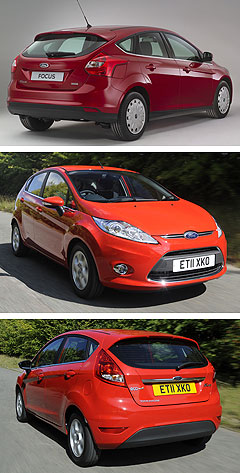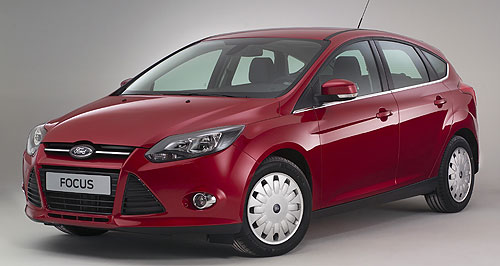Future models - Ford - Focus - EconeticFrankfurt show: New Ford Focus as clean as PriusFrugal Ford: New Focus Econetic will consume just 3.4L/100km and emit a Prius-matching 89g/km of CO2. Ford looks set to smash its own fuel-efficiency record with new eco Fiesta and Focus9 Sep 2011 FORD’S new Focus will dethrone Toyota’s Prius as the undisputed small-car economy champion when a super-frugal Econetic version that delivers fuel consumption of just 3.4L/100km – the equivalent of more than 83mpg - is unveiled at next week’s Frankfurt motor show. Due on sale in Europe by mid-2012 but not yet confirmed Australia, Ford says the all-new Focus Econetic will not only be Europe’s most fuel-efficient non-hybrid family (C-segment) car, but will match the Prius with a CO2 emissions figure of just 89g/km. The smaller Fiesta Econetic lowered the Toyota hybrid icon’s long-running fuel consumption benchmark from 3.9L/100km to 3.7L/100km when it was released here in December 2009, but Prius proponents point to the diesel-powered, manual-only Fiesta’s higher emissions of CO2, the major greenhouse gas. Now, however, Ford has not only undercut the Prius for fuel economy and matched it for CO2 emissions with its first Focus Econetic, but also applied a comprehensive efficiency program to lower the Fiesta Econetic’s consumption to just 3.3L/100km and its CO2 emissions to only 87g/km. Proving there is plenty of efficiency left yet in downsized diesel engine technology, the upgraded Fiesta Econetic – which will also hit Europe in mid-2012 but is yet to be locked in for release here – is 0.4L/100km and 11g/km more efficient than today’s Fiesta range-topper, which consumes 3.7L/100km, emits 98g/km and costs $24,990. At 3.4L/100km and 89g/km, meantime, Ford’s comparably sized Focus Econetic will consume half a litre less fuel per 100km than the Prius and match it for CO2 emissions, while bettering Volkswagen’s new Golf BlueMotion (3.8L/100km, 99g/km) by 0.4L/100km and 10g/km. Given the tendency of diesel vehicles to more closely match than hybrids the official fuel consumption ratings of car-makers anywhere away from stop-start city traffic, it is likely both the Fiesta and Focus Econetics will offer significantly lower real-world fuel consumption and CO2 emissions than the Prius. What is more, both models also eliminate the other diesel-versus-hybrid argument propagated by promoters of the petrol-electric Prius – exhaust particulate matter and oxides of nitrogen, or NOx, which is harmful to humans. But both Econetic Technology models will be the first Ford diesels to feature a lean NOx trap, which absorbs NOx emissions and neutralises then into nitrogen and water in its regeneration phase. Fitted in conjunction with a coated diesel particulate filter, Ford says the NOx trap was developed initially to address only NOx emissions, but turns out to be a key factor in both models’ record-low CO2 emissions levels because it allows the engine’s combustion process to run leaner and more efficiently. At the heart of both the Econetic-badged Focus and Fiesta is a specifically developed version of the 1.6-litre TDCi Duratorq turbo-diesel that powers Europe’s new third-generation Focus, which went on sale here last month with 2.0-litre petrol and diesel engines and an entry-level 1.6 petrol four. Ford says the key to its increased efficiency, which betters Ford’s own previous estimates of 3.5L/100km and “less than 95g/km”, is a reworked 1.6 TDCi that produces 70kW in the Fiesta Econetic and 78kW in the Focus Econetic. It features a redesigned common-rail fuel-injection system with improved eight-hole injectors controlled by a more powerful engine management system to deliver more precise control and increased combustion efficiency. Ford has also fitted a new variable-geometry turbocharger instead of the Fiesta’s fixed-geometry unit, while more accurately controlling charge air temperatures is a water-cooled (rather than the standard Fiesta’s air-to-air) intercooler to reduce pumping losses and deliver a cooler, denser charge under acceleration. Also eking more efficiency from the 1.6 TDCi by reducing mechanical losses is a low-friction piston ring coating, variable-flow oil pump, low-inertia vacuum pump and asymmetric crank sprocket design. Complimenting the engine upgrade is an exclusive aerodynamic package for both models, including undershields, deflectors and rear wheel-arch spoilers to make both cars more slippery and improve the new Focus five-door’s already-impressive drag coefficient of 0.295 Cd. In addition, the Focus Econetic scores an Active Grille Shutter that optimises aerodynamics and engine temperature control.  Left: Focus Econetic. Below: Fiesta Econetic. Left: Focus Econetic. Below: Fiesta Econetic.Similar to the systems found on a number of luxury vehicles including BMWs, making Ford the only mass-market brand to offer the system, it employs a motor-driven front air-vent that is automatically adjusted by the ECU over 16 positions according to engine airflow requirements, reducing CO2 emissions by up to two per cent when fully closed. Also contributing to the ultra-low fuel consumption of both models is Ford’s idle-stop system, Auto-Start-Stop. By automatically shutting down the engine at idle, Ford says it can reduce fuel consumption and CO2 emissions by up to 10 per cent in urban driving. There is also an enhanced version of the Smart Regenerative Charging system already seen in some overseas Ford models, which increases the alternator output when the vehicle brakes or decelerates to convert kinetic energy into electric energy for the battery without using extra fuel. Of course, both models also score Ford Eco Mode and a Shift Indicator Light, which encourage more economical driving by tracking and presenting fuel consumption progress and suggesting when to change up gears. At this stage both Econetic models are available only with a manual transmission (six-speed for the Focus, five-speed for the Fiesta), which in this case feature lower internal friction, revised gear ratios and a longer final drive. All of this is matched in both Econetic models with electric power-assisted steering, low-friction engine and transmission oils, low rolling resistance tyres, a low-tension front-end accessory drive and thermal management systems to further optimise engine warm-up. “The Focus and Fiesta Econetic Technology will deliver stunning fuel economy and still be fun to drive – a combination that would have seemed impossible a few years ago,” said Ford of Europe sustainability and electrification strategy manager Dr Thilo Seibert. Apart from the 1.6 TDCi engine, Ford’s Econetic Technology badge will also be applied to models with a 1.6-litre EcoBoost turbo-petrol engine and Ford’s new 1.0-litre three-cylinder EcoBoost petrol engine, which is also turbocharged and direct-injected. The latter will be presented in the Focus at Frankfurt, while all Econetic commercial vehicles will be powered by lean Stage 5 TDCi diesel engines. Ford says half of all Blue Oval cars sold in Europe by late next year will carry the Econetic Technology badge – increasing to two-thirds by mid-2013 – while Auto-Start-Stop will be available in every Ford car line from end of 2012. Ford’s answer to VW’s Bluemotion is part of its promise to reduce the CO2 emissions of its cars by 30 per cent between 2006 and 2020. Since 2006, Ford says it has achieved an 11 per cent reduction in CO2 and will reduce its fleet-average CO2 figure by a further 10g/km within the next two years. It said more than 30 low-emission European models will qualify to wear the Econetic badge between now and the end of next year, including the Fiesta, C Max, Grand C-Max, Focus, Mondeo, S-Max and Galaxy by the end of this year. Given Australia’s new Focus is sourced from Europe, Ford Australia spokesman Justin Lacy said it is logical to assume they will also eventually become available with idle-stop technology, but neither the Focus Econetic, upgraded Fiesta Econetic or idle-stop for the new Focus have yet been confirmed for the Australian market. “There are no plans to introduce Focus Econetic to Australia at this stage,” he said. “Fiesta Econetic is obviously already here and, yes, our (Focus) cars come from Europe production. “But given the mid-2012 EU market introduction timing, anything for our market is beyond that from a timeframe standpoint, which puts it 12 months away at least, so too far out for us to be discussing or confirming future product actions. “I understand you want to me to confirm that we'll be getting Auto-Start-Stop technology here as well, which is obviously a logical conclusion based on us taking vehicles out of Europe, but I can't confirm that for you at this stage.” Complicating matters is the fact Focus production for Australia will switch from Germany to Thailand when a new Focus plant ramps up there from next year. However, all Fiesta models sold in Australia are already built in Thailand – except the Econetic, which comes from Europe. Although Ford is yet to announce a hybrid Focus, it has committed to releasing its zero-emissions Focus Electric in the US and Europe next year. Ford Australia has confirmed the Focus EV is almost certain to be its first all-electric model, but has not yet said when. The Focus Electric will be followed in 2013 by the C-Max Hybrid and C-Max Energi plug-in hybrid, while Ford’s all-new Escape/Kuga compact SUV – which could also debut at Frankfurt next week – is expected to be available with hybrid power too.  Read moreAll motor show Alfa Romeo Alfa Romeo Abarth Abarth Audi Audi Aston Martin Aston Martin BMW BMW Bentley Bentley Chrysler Chrysler Chevrolet Chevrolet Dodge Dodge Citroen Citroen Ferrari Ferrari DS DS Ford Ford Fiat Fiat FPV FPV Foton Foton Haval Haval Great Wall Great Wall Honda Honda Holden Holden Hyundai Hyundai HSV HSV Isuzu Isuzu Infiniti Infiniti Jeep Jeep Jaguar Jaguar Lamborghini Lamborghini Kia Kia Lexus Lexus Land Rover Land Rover Mazda Mazda Maserati Maserati Mercedes-Benz Mercedes-Benz McLaren McLaren Mini Mini Nissan Nissan Mitsubishi Mitsubishi Peugeot Peugeot Opel Opel Proton Proton Porsche Porsche Renault Renault Ram Ram Saab Saab Rolls-Royce Rolls-Royce Smart Smart Skoda Skoda Subaru Subaru SsangYong SsangYong Tesla Tesla Suzuki Suzuki Toyota Toyota Volvo VolvoMotor industry news |
Click to shareAll motor show Alfa Romeo Alfa Romeo Abarth Abarth Audi Audi Aston Martin Aston Martin BMW BMW Bentley Bentley Chrysler Chrysler Chevrolet Chevrolet Dodge Dodge Citroen Citroen Ferrari Ferrari DS DS Ford Ford Fiat Fiat FPV FPV Foton Foton Haval Haval Great Wall Great Wall Honda Honda Holden Holden Hyundai Hyundai HSV HSV Isuzu Isuzu Infiniti Infiniti Jeep Jeep Jaguar Jaguar Lamborghini Lamborghini Kia Kia Lexus Lexus Land Rover Land Rover Mazda Mazda Maserati Maserati Mercedes-Benz Mercedes-Benz McLaren McLaren Mini Mini Nissan Nissan Mitsubishi Mitsubishi Peugeot Peugeot Opel Opel Proton Proton Porsche Porsche Renault Renault Ram Ram Saab Saab Rolls-Royce Rolls-Royce Smart Smart Skoda Skoda Subaru Subaru SsangYong SsangYong Tesla Tesla Suzuki Suzuki Toyota Toyota Volvo VolvoMotor industry news |
















Facebook Twitter Instagram